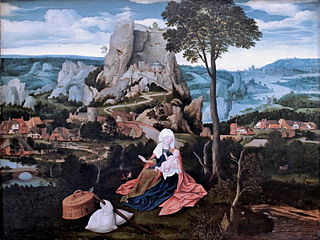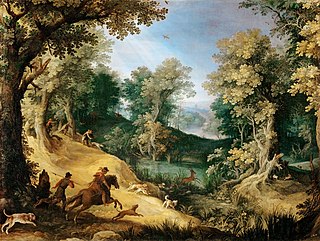
Hans Heinrich August Gábor Tasso Thyssen-Bornemisza de Kászon, Baron Thyssen-Bornemisza, was a Dutch-born Swiss industrialist and art collector. A member of the Thyssen family, he had a Hungarian title and was heir to a German fortune.

Claude-Joseph Vernet was a French painter. His son, Antoine Charles Horace Vernet, was also a painter.

Paris Bordone was an Italian painter of the Venetian Renaissance who, despite training with Titian, maintained a strand of Mannerist complexity and provincial vigor.

Joachim Patinir, also called Patenier, was a Flemish Renaissance painter of history and landscape subjects. He was Flemish, from the area of modern Wallonia, but worked in Antwerp, then the centre of the art market in the Low Countries. Patinir was a pioneer of landscape as an independent genre and he was the first Flemish painter to regard himself primarily as a landscape painter. He effectively invented the world landscape, a distinct style of panoramic northern Renaissance landscapes which is Patinir's important contribution to Western art. His work marks an important stage in the development of the representation of perspective in landscape painting.

The Thyssen-Bornemisza National Museum, or simply the Thyssen, is an art museum in Madrid, Spain, located near the Prado Museum on one of the city's main boulevards. It is known as part of the "Golden Triangle of Art", which also includes the Prado and the Reina Sofía national galleries. The Thyssen-Bornemisza fills the historical gaps in its counterparts' collections: in the Prado's case this includes Italian primitives and works from the English, Dutch and German schools, while in the case of the Reina Sofía it concerns Impressionists, Expressionists, and European and American paintings from the 20th century.

Johann Rottenhammer, or Hans Rottenhammer, was a German painter. He specialized in highly finished paintings on a small scale.

Joos de Momper the Younger or Joost de Momper the Younger was a Flemish landscape painter active in Antwerp between the late 16th century and the early 17th century. Brueghel's influence is clearly evident in many of de Momper's paintings. His work is situated at the transition from late 16th-century Mannerism to the greater realism in landscape painting that developed in the early 17th century. He achieved considerable success during his lifetime.

Marten Ryckaert or Maerten Ryckaert, was a Flemish landscape painter. He was known for his small, usually imaginary landscapes in an Italianate style.

Landscape with Charon Crossing the Styx is an oil on wood painting by the Flemish Northern Renaissance artist Joachim Patinir. Dating to c. 1515–1524, it is now in the Museo del Prado, in Madrid.

Tobias Verhaecht (1561–1631) was a painter from Antwerp in the Duchy of Brabant who primarily painted landscapes. His style was indebted to the mannerist world landscape developed by artists like Joachim Patinir and Pieter Bruegel the Elder. He was the first teacher of Pieter Paul Rubens.

Jacob Grimmer was a Flemish landscape painter and draughtsman. His rural scenes and landscapes of views around Antwerp marked an important development in 16th century Flemish landscape painting away from the world landscape with its fantastic panoramas and whimsically shaped gigantic rocks towards greater simplicity and authenticity. His work influenced the next generation of Flemish landscape painters. Grimmer was a capable colorist who was able to create harmonic landscapes by using realistic colours and atmospheric values effectively.

Carlos Sebastián Pedro Hubert de Haes was a Spanish painter from Belgium. He was noted for the Realism in his landscapes, and was considered to be the "first contemporary Spanish artist able to capture something of a particularly Spanish 'essence' in his work". He was cited along with Jenaro Perez Villaamil and Aureliano de Beruete as one of the three Spanish grand masters of landscape painting, the latter of which was his pupil.

The world landscape, a translation of the German Weltlandschaft, is a type of composition in Western painting showing an imaginary panoramic landscape seen from an elevated viewpoint that includes mountains and lowlands, water, and buildings. The subject of each painting is usually a Biblical or historical narrative, but the figures comprising this narrative element are dwarfed by their surroundings.

Rest on the Flight into Egypt is a c. 1515 oil on panel painting by the Flemish artist Joachim Patinir, who painted the main figures of Madonna and Child and a foreground still-life. The background landscape includes colours not usually found in Patinir's work and so is thought to have been produced by other hands. It is now in the Gemäldegalerie, Berlin.

Francis Augustus Silva was an American Luminist painter of the Hudson River School. His specialty was marine scenes, particularly of the Atlantic coast, a genre in which he masterfully captured the subtle gradations of light in the coastal atmosphere. He focused on romantic scenes, avoiding depictions of seaside recreation, even when painting scenes at Coney Island, which was then already a popular recreational area.

Landscape with Sea and Mountain is an oil-on-canvas painting by Flemish painter Joos de Momper. It was painted in the early 1620s, and is now in the Museum of Prado in Madrid.

Mountainous Landscape with Saint Jerome is an oil on copper painting by Flemish painter Paul Bril. It was painted in 1592, and is currently housed at the Mauritshuis in The Hague. The painting was acquired by the Mauritshuis in March 2013. The painting is signed and dated, and represents the earliest dated cabinet painting by Bril. The painting belongs to the period when Bril associated with Jan Brueghel the Elder in Rome, in the last decade of the 16th century. Bril's work from the 1590s has some affinity to the work by Brueghel from the same period, and in fact the painting was originally considered a Brueghel.

Stag Hunt is an oil on canvas painting by Flemish painter Paul Bril. It was probably painted in the 1590s, and is currently housed at the Louvre in Paris. The painting was once part of the collection of Louis XIV.

Alpine Landscape is an oil-on-canvas painting by Flemish painter Tobias Verhaecht. The painting was completed between 1600 and 1615, and is now in the Museum of Prado in Madrid.

Mountainous River Landscape with Travelers is an early-17th-century oil painting on panel by Flemish painter Tobias Verhaecht. The painting was sold to an unknown buyer at Sotheby's in New York City, on January 26, 2016.





















